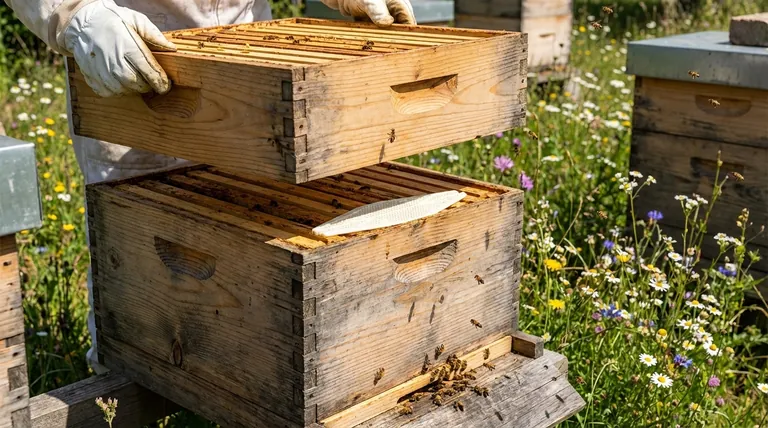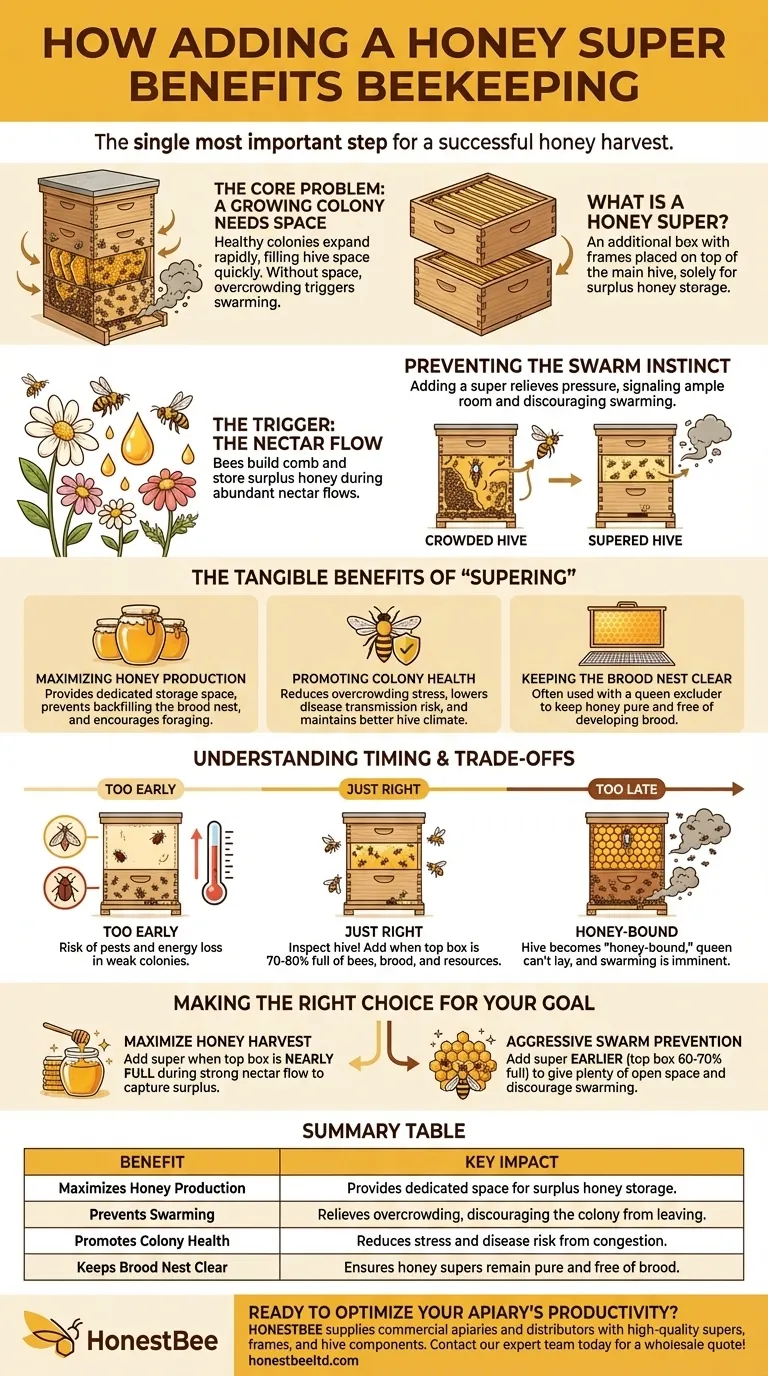Adding a honey super is the single most important step for a successful honey harvest. By providing a dedicated space for surplus honey storage, a super enhances production and crucially supports the colony's health. This prevents overcrowding and the natural instinct to swarm, ensuring your bees remain productive and focused within the hive.
A super isn't just an extra box for honey; it is a strategic tool for hive management. It redirects the colony's energy from swarming towards storing a surplus harvest, directly aligning the bees' natural behavior with the beekeeper's goals.

The Core Problem: A Growing Colony Needs Space
A healthy bee colony is programmed for one thing: expansion. As the population grows and nectar becomes abundant, the internal hive space quickly fills. Without intervention, this leads to a predictable outcome.
What is a Honey Super?
A super is simply an additional box, filled with frames, that you place on top of the main hive body. Its sole purpose is to give the bees a place to store honey that is not needed for the immediate survival of the brood nest.
The Trigger: The Nectar Flow
Bees will only build out comb and store surplus honey when there is a nectar flow—a period when flowers are producing abundant nectar. During this time, foraging bees bring back far more than the colony can consume, and they need a place to store it.
Preventing the Swarm Instinct
When a hive runs out of space, it triggers a natural survival mechanism: swarming. The queen and about half the worker bees will leave to find a new home. Adding a super relieves this population pressure, signaling to the colony that there is ample room to expand, which effectively discourages them from swarming.
The Tangible Benefits of "Supering"
Giving your bees more room at the right time produces clear, positive results for both the bees and the beekeeper.
Maximizing Honey Production
This is the most direct benefit. The super provides empty real estate for honey storage. Without this space, bees will store nectar in any available cell, often "backfilling" the brood chamber and slowing the queen's laying rate, which limits future population growth and honey collection.
Promoting Colony Health
A congested hive is a stressed hive. Overcrowding can increase the transmission of pests and diseases and raise the internal temperature and humidity. Providing adequate space creates a healthier, less stressful environment for the colony.
Keeping the Brood Nest Clear
Often, a queen excluder is placed between the main hive body and the honey supers. This screen has openings large enough for worker bees but too small for the queen. This ensures she remains in the lower boxes laying eggs, keeping the honey in the supers pure and free of developing bees (brood).
Understanding the Trade-offs and Timing
The benefits of adding a super are entirely dependent on correct timing. Acting too early or too late can create new problems.
The Risk of Adding a Super Too Early
If you add a super before the colony is strong enough, the bees may not be able to patrol or regulate the temperature of the new space. This can make the hive vulnerable to pests like wax moths and small hive beetles, and it forces the bees to expend energy heating an unnecessarily large cavity.
The Consequence of Adding a Super Too Late
If you wait too long, the hive will become "honey-bound," meaning every available cell is filled with nectar. The queen will have nowhere to lay, and swarm preparations will likely already be underway. Once this process starts, it is very difficult to stop.
The Importance of Inspection
The only way to know the right time is to inspect your hive. The key indicator is seeing that the top-most hive box is approximately 70-80% full of bees, brood, and resources. This signals that they will need more space very soon.
Making the Right Choice for Your Goal
Deciding when to add a super depends on your primary objective for the season.
- If your primary focus is maximizing your honey harvest: Add a super when the top hive box is nearly full during a strong nectar flow to capture every drop of surplus.
- If your primary focus is aggressive swarm prevention: Add a super a bit earlier, when the top box is about 60-70% full, to give the colony plenty of open space and discourage any thought of swarming.
Properly timing your super is the most impactful decision you will make for a productive and healthy hive.
Summary Table:
| Benefit | Key Impact |
|---|---|
| Maximizes Honey Production | Provides dedicated space for surplus honey storage. |
| Prevents Swarming | Relieves overcrowding, discouraging the colony from leaving. |
| Promotes Colony Health | Reduces stress and disease risk from congestion. |
| Keeps Brood Nest Clear | Ensures honey supers remain pure and free of brood (often with a queen excluder). |
Ready to optimize your apiary's productivity?
At HONESTBEE, we supply commercial apiaries and beekeeping equipment distributors with the high-quality supers, frames, and hive components needed for successful hive management. Our wholesale-focused operations ensure you get the reliable equipment to maximize your honey harvest and maintain healthy colonies.
Contact our expert team today to discuss your beekeeping supply needs and request a wholesale quote!
Visual Guide

Related Products
- High-Efficiency Diamond Maze Bee Escape for Clearing Supers
- Economy Small Scale Honey Dryer Dehumidifier Thickening Machine
- Commercial 48-Frame Stainless Steel Honey Extractor
- Classic Wooden Bee Brush with Double-Row Boar Bristles
- Wooden Bee Brush with Double-Row Horsehair Bristles
People Also Ask
- What is a bee escape and why is it used in beekeeping? A Guide to Gentle Honey Harvesting
- What is the result of using a bee escape board for 24 hours? Achieve a Near Bee-Free Honey Super
- What was the result of using the bee escape board? Achieve a Calm, Low-Stress Honey Harvest
- How long should a bee escape be placed before harvesting honey? The 24-48 Hour Guide to a Stress-Free Harvest
- Where should the Bee Escape board be placed? For a Calm, Bee-Free Honey Harvest



















